The human cost of insulin in America
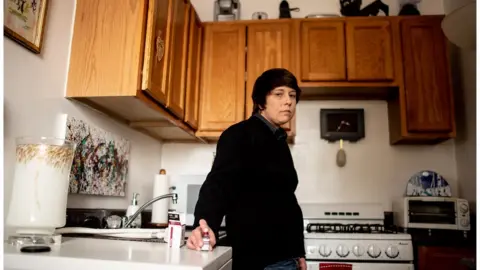 BBC
BBCThis is the list of what Laura Marston has sacrificed to keep herself alive: Her car, her furniture, her apartment, her retirement fund, her dog.
At 36 years old, she has already sold all of her possessions twice to afford the insulin her body needs every day.
Insulin is not like other drugs. It's a natural hormone that controls our blood sugar levels - too high causes vision loss, confusion, nausea, and eventually, organ failure; too low leads to heart irregularities, mood swings, seizures, loss of consciousness.
For most of us, our bodies produce insulin naturally. But for Type 1 (T1) diabetics like Ms Marston, insulin comes in clear glass vials, handed over the pharmacy counter each month - if they can afford it.
One vial of the insulin Ms Marston uses now costs $275 (£210) without health insurance.
In 1923, the discoverers of insulin sold its patent for $1, hoping the low price would keep the essential treatment available to everyone who needed it.
Now, retail prices in the US are around the $300 range for all insulins from the three major brands that control the market.
Even accounting for inflation, that's a price increase of over 1,000%.
Stories of Americans rationing insulin - and dying for it - have been making national headlines.
The most famous case, perhaps, was 26-year-old Alec Smith, who died in 2017 less than a month after he aged out of his mother's health insurance plan. Despite working full-time making more than minimum wage, he could not afford to buy new insurance or pay the $1,000 a month for insulin without it.
 Getty Images
Getty ImagesMs Marston knows the feeling - like most of the diabetics I spoke to, she has experienced frightening lapses in coverage through no fault of her own.
A few years ago, when the small law firm Ms Marston worked for abruptly closed, she found herself without an income and suddenly uninsured.
"I was spending $2,880 a month just to keep myself alive - that was more than I was making even working 50 hours a week," says Ms Marston.
She was forced to leave her home in Richmond, Virginia, to find a new job in Washington DC to ensure she could pay for insulin.
"I sold everything, including my car, and had to give up my dog - he was eight and I had to give him away - and move to DC."
There are any number of reasons why someone might still be uninsured in America - if they don't qualify for employer-sponsored insurance or lose their job like Ms Marston had, for example, or if they cannot afford to pay for a plan on their own.
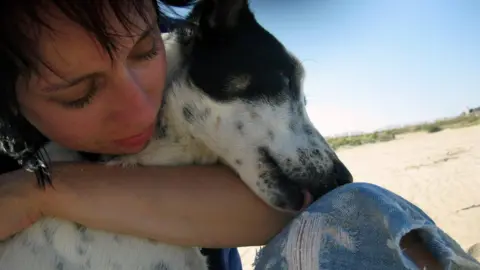 Laura Marston
Laura MarstonMs Marston was diagnosed with T1 diabetes when she was 14. She laughs when recalling how the price of insulin in 1996 - $25 for one vial - was a shock to her.
Two decades later, Ms Marston still uses the same formula of insulin - Eli Lilly's Humalog. Even the packaging is the same.
"Nothing about it has changed, except the price has gone up from $21 a vial to $275 a vial."
It's the same story for Sanofi's Apidra and Novo Nordisk's Novolog.
So who's to blame?
Most patients point the finger at the pharmaceutical companies, who in turn bring up problems with government regulations and insurance providers.
At the heart of the issue is the complex mystery around who pays what for insulin in the US.
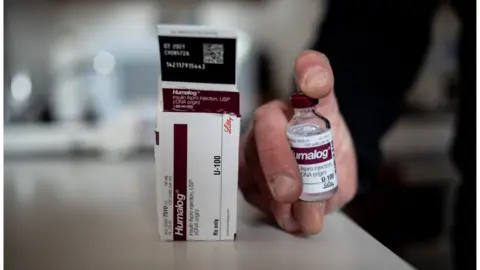 BBC
BBCThere are five terms essential to this discussion - list price, net price, rebates, co-payments and deductibles.
- List price is set by a pharmaceutical company, and in many cases is what uninsured diabetics pay
- Net price is the actual profit the company receives for a drug
- Rebates are discounts on drugs negotiated for insurance companies
- Co-payments are what an insured person pays for a prescription, out-of-pocket
- Deductibles, which can be as high as $10,000, are what insurance policies say must be paid before the insurer picks up the rest
Insurance companies enlist third-party negotiators, called pharmacy benefit managers, to fix discounts with drug manufacturers that in turn result in smaller co-payment prices for their users. Experts say part of the system's problem is a lack of transparency around how these rebates are negotiated and how much actually makes its way to patients.
This system also means that insurers end up with different rates for each drug company, so a brand of insulin that has a minimal co-pay under one insurance could cost the full list price under another.
Ms Marston has been tracking insulin list prices for years. By her calculations, for insulin alone, she'll need close to $7m to live until she's 70 if she pays out of pocket.
"It's led to a situation where I decided I couldn't have kids because I don't feel financially stable enough," Ms Marston says.
But drug manufacturers argue that very few people ever face paying list price.
Eli Lilly said in a statement to the BBC that 95% of people using Humalog in the US pay under $100 a month for their prescription, and that of the 600,000 using Humalog, "about 1,600 people without insurance have not utilised the [assistance] benefits we offer".
Novo Nordisk and Sanofi detailed similar patient assistance programmes in their statements. And several diabetics I spoke to did say that these programmes helped them- if they qualified.
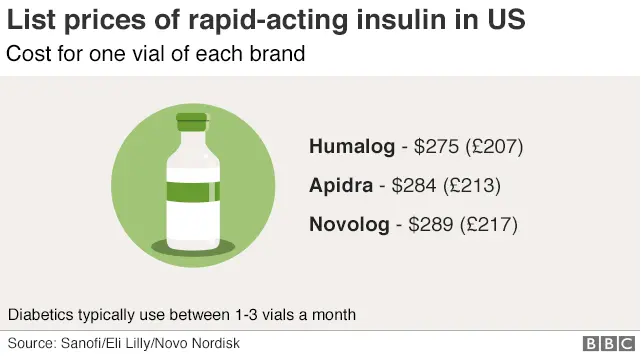 BBC
BBCBut another advocate, Kristen Daniels, says she was faced with a $2,400 price tag for one month of insulin and because she was technically insured, she couldn't get assistance.
"I called my insurance, I called the manufacturer, and no one could help me because I hadn't reached my deductible," Ms Daniels says.
Pharmaceutical companies have also emphasised that rising list prices did not result in commensurate profits. Eli Lilly's spokesman says their net price has actually gone down in the last five years; Sanofi's said their insulin profits are 25% lower in 2019 than 2012.
According to a report by the American Diabetes Association (ADA) and the University of Southern California Center for Health Policy and Economics, between 2007 and 2016, major brand insulin list prices have increased by 252%, while net prices saw less growth at 57%.
And there are cheaper options in the US for some: WalMart insulin, for example, is a re-branded version of a Novo Nordisk formula which retails for around $25 per vial in most states. But the formula is older, less effective, and some, like Ms Marston, are allergic to it.
This is another key issue in the debate around skyrocketing insulin prices. Each formula works differently for each individual. It takes many T1 patients years to feel comfortable managing their dosing with a particular brand.
Several diabetics I spoke to say they have been forced to switch insulins by their insurance plans - even against the recommendation of their physicians - if they wanted to avoid paying the list price for their preferred brand.
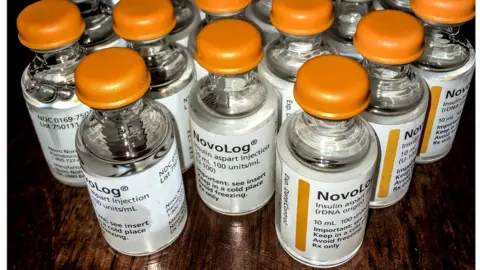 BBC
BBCThe ADA says this "non-medical switching" is more than an inconvenience - it's potentially dangerous, requiring constant monitoring on the patient's part and consultations with a physician.
Serious or permanent complications like blindness or kidney disease can arise if a diabetic is put through too many extreme sugar highs and lows.
In America, where insurance coverage goes hand-in-hand with employment and options are limited, many T1 diabetics make sacrifices in other parts of their lives to keep affording insulin - whether that's staying with a stressful job or switching insulin formulas at the behest of an insurer.
The expression that comes up again and again in the US T1 community is: "We're hostages".

How does the UK compare?
T1International is a non-profit advocating for affordable, accessible diabetes care worldwide. Founder Elizabeth Rowley is an American who now lives in the UK.
As a T1 diabetic herself, Ms Rowley has first-hand experience navigating both health systems. She describes the US system as "convoluted", with profits happening at all levels in between.
"People spend most of their life in fear of losing their insurance, of running out of insulin and the cost going up, or of having to stay in terrible jobs or relationships to ensure they keep their health insurance coverage," Ms Rowley tells me. "That's the best case scenario.
"Worst case, folks are rationing insulin which has led to many reported deaths and excruciating complications. People are buying and sharing insulin from people online they have never met, having to choose between buying food, paying rent, or taking their medicine."
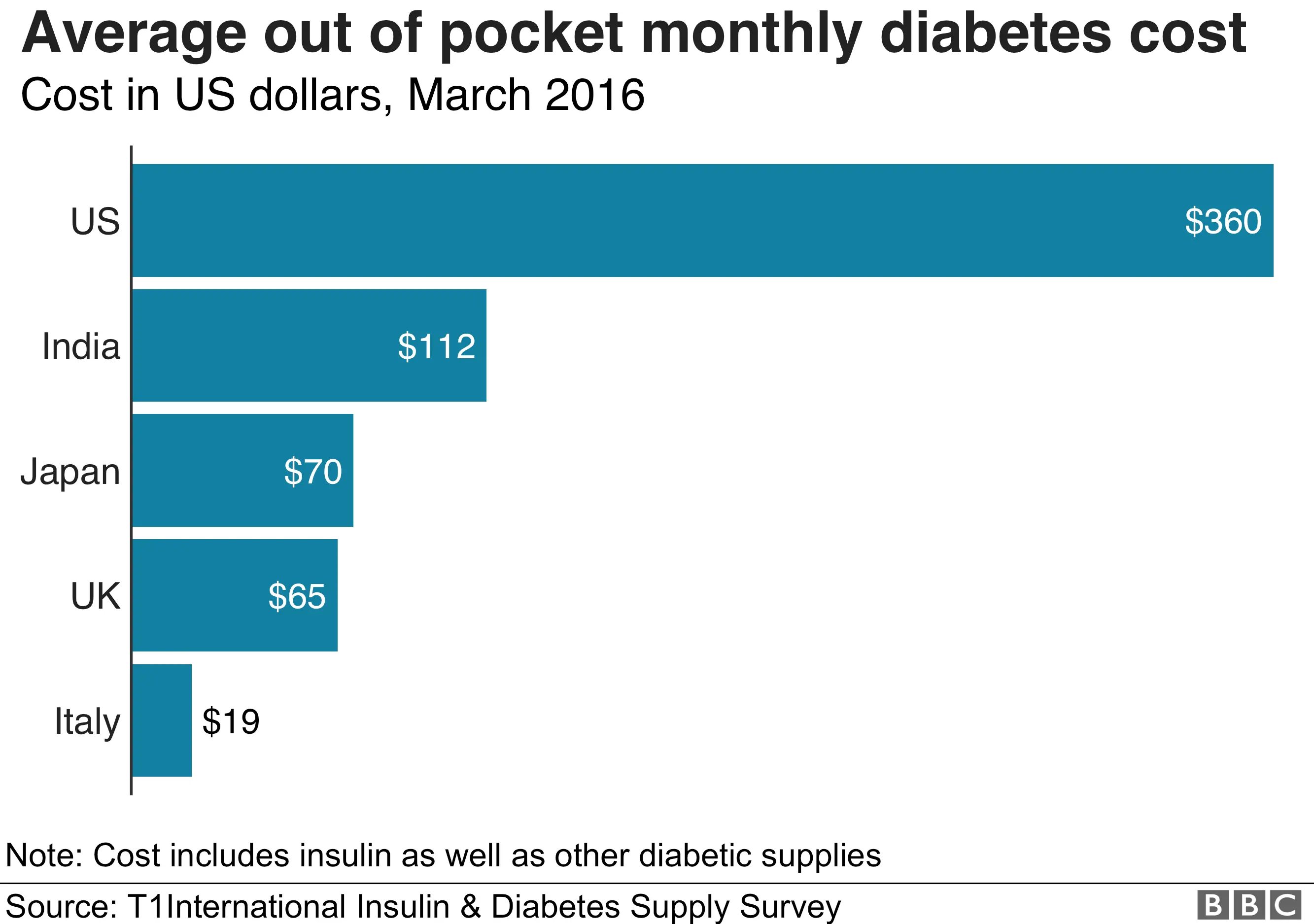 BBC
BBCDiabetics in the US pay on average over $210 each month for insulin, according to a T1International 2016 survey, compared to less than $50 in India or nothing at all in some European countries.
"In the UK, I walked into the pharmacy, and with my medical exemption card, picked up my essential medicines. While the NHS is still overpaying for insulin, the cost it pays is miniscule compared to what people in the US must pay."
Ms Rowley acknowledges these other systems aren't perfect - but to her, they are still far better for patients.

The medical tourists
Lauren Hyre, 30, an Arizona-based advocate for T1International, knows first hand the fears of accessing insulin in the US system. She's struggled with it for two-thirds of her life.
Her father passed away when she was nine and his company cut off the family's health insurance. Before Obamacare, diabetics could be denied insurance, and so Ms Hyre was without coverage for years.
Living in Indiana, a state without expanded health assistance programmes, she also didn't qualify for any government help.
For years, Ms Hyre depended upon expired vials of insulin from her doctor's office and making trips to Canada to buy it at an affordable cost.

More voices on healthcare:

The first time she bought insulin at a Canadian pharmacy, her mother broke down in tears.
There are dozens of similar stories across the southern border too.
When 27-year-old Emily Mackey heard about a group of diabetics travelling to Tijuana, Mexico, to purchase cheaper insulin, she reached out on Instagram and joined in.
Ms Mackey was already in California for work, and so her tram ride from San Diego to Tijuana, Mexico, cost $5, round-trip.
A six-month supply of insulin set her back $100, a lot lower than the $1,300 cost if purchased through her insurance.
 Emily Mackey
Emily MackeyBut her relief soon turned to aggravation. Even if she had flown from her home in Philadelphia, buying insulin across the border would have saved her money.
"I was angry that I had to go to Mexico in the first place to get a drug that keeps me alive. I live right next to a [US pharmacy], yet had to travel 3,000 miles to another country to get affordable insulin."

What are the solutions?
According to the American Diabetes Association (ADA), there are more than seven million diabetics in this country, and around 27% say that affording insulin has impacted their daily life.
Dr William Cefalu, the ADA's chief scientific, medical and mission officer, says a lack of transparency is at the root of the issue.
"The system is dysfunctional. There are issues at each level, at each stakeholder in the insulin supply chain," he says. "We can't point the finger at one particular entity."
Fixing issues with high deductibles and ensuring any discounts negotiated with insurance companies actually filter down to patients is key, he says.
Competition would be the best way to bring prices down, so why hasn't that happened yet?
Unlike chemical drugs, which can be simply replicated, insulin is a biological material - made up of proteins synthesised through a cell line that's unique to each formula.
Novo Nordisk, Eli Lilly and Sanofi's insulins are all slightly different in this way, and no "generic" or un-branded copy could be made without accessing these companies' patented materials and processes.
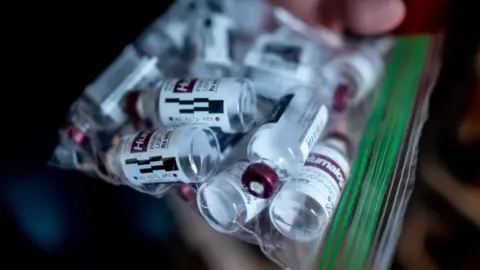 BBC
BBCBut despite these fundamental differences, insulin has long been classified and regulated like a chemical drug.
In December, the FDA announced that the agency would reclassify insulin as a "biological product" by 2020, in what the FDA commissioner called a "watershed moment for insulin".
These so-called biologics will then have an easier pathway to approval than before, promoting the development of "products that are biosimilar to, or interchangeable with" existing insulin.
Insulin isn't the only drug affected by the tangled web of regulations and closed-door industry dynamics, but it is one of the few with life-or-death consequences attached to its price tag.
For Ms Marston, it's hard to see why insulin was ever treated like other medications.
"It's a natural hormone that everybody else's bodies make that ours don't," she says. "There should be price caps on it just like everything else that's required for life: your water bill, your electric bill. Arguably those things are even less required than Humalog."
As an increasingly vocal Congress continues to hold hearings on drug pricing, pharmaceutical companies are beginning to feel the pressure.
Eli Lilly has announced it would be offering a new "generic" version of Humalog for half the cost. But the $137 price tag for this new generic is still steep - and significantly above what other countries pay for the same insulin.
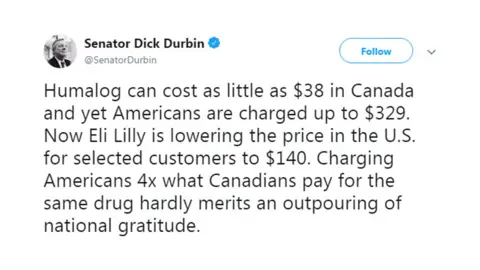 Twitter
TwitterIt's a move that may reduce what some pay at the pharmacy, but one that fails to address the systemic issues around insulin pricing.
Senator Elizabeth Warren, a 2020 presidential hopeful, and Representative Jan Schakowsky, both Democrats, proposed a different solution in December.
The Affordable Drug Manufacturing Act would order the Department of Health and Human Services to create a new office focusing on manufacturing generic drugs "in cases where the market has failed" in order to "jump-start" competition.
The bill is unlikely to pass but it signals a serious interest from some lawmakers to change the existing system.
Another avenue is the Medicare for All proposal pushed by Senator Bernie Sanders and other 2020 candidates, which would provide free healthcare for all, funded by higher taxes.
As the debate continues on Capitol Hill and in industry board rooms, Ms Marston says she wants to continue her own advocacy on behalf of those who have fallen through the insurance gaps.
"In an instant, they were faced with having to pay list prices and could not do that, and that is why they died.
"If even one person has to pay list price, that's not fair," Ms Marston says.
"It's really someone having a gun to your head and saying: Your money or your life."
Photographs by Hannah Long-Higgins
.
